Effect of Freeze–Thaw Cycles on Microstructure and Hydraulic Characteristics of Claystone: A Case Study of Slope Stability from Open-Pit Mines in Wet Regions
Abstract
1. Introduction
2. Materials and Methods
2.1. Claystone
2.2. Experimental Apparatus and Testing Method
3. Results
3.1. Two-Dimensional Distribution of Fissures
3.2. Three-Dimensional Distribution of Fissures
3.3. Permeability Properties
4. Discussion
5. Conclusions
- Micro-CT results disclose that undisturbed claystone initially possesses numerous isolated fissures, which gradually develop and expand, ultimately forming many interconnected fissures under the action of F–T cycles. Grayscale images obtained by Micro-CT scanning provide valuable insights into the changing pattern of internal fissures during multiple F–T cycles.
- The 3D fissures reconstructed by 2D grayscale slices visually illustrate the morphological changes in microstructure of claystone during F–T cycles.
- Pores and fissures extracted from the Micro-CT images change greatly along with axial direction and demonstrate noticeable discreteness. The heterogeneity of pore distribution indicates that F–T cycles enhance the spatial complexity in distribution of fissures in claystone.
- Macroscopic fissures in claystone result from the accumulation of tiny internal fissures through continuous sprouting and confluence. As the number of F–T cycles increases from 0 to 50, the porosity volume of internally interconnected fissures increases significantly for interconnected fissures. These findings signify that interconnected fissures are the key factor determining the degree of fissure development in claystones under the action of F–T cycles.
- Extracting interconnected fissures with dynamic connectivity properties is a crucial foundation for numerical simulation of the seepage property of claystones. The evolutionary rule of permeability is verified through both numerical seepage simulation and experimental results.
- The propagating fissures resulting from F–T cycles not only weaken the integrity of rocks but also augment permeability in claystone, potentially leading to frost heave damage and geotechnical hazards of open-pit slopes in wet regions.
Author Contributions
Funding
Data Availability Statement
Acknowledgments
Conflicts of Interest
References
- Lu, Y.; Liu, S.H.; Zhang, Y.G.; Wang, L.J.; Li, Z. Hydraulic conductivity of gravelly soils with various coarse particle contents subjected to freeze–thaw cycles. J. Hydrol. 2021, 598, 126302. [Google Scholar] [CrossRef]
- Ma, Q.Y.; Ma, D.D.; Yao, Z.M. Influence of freeze-thaw cycles on dynamic compressive strength and energy distribution of soft rock specimen. Cold Reg. Sci. Technol. 2018, 153, 10–17. [Google Scholar] [CrossRef]
- Azmatch, T.F.; Sego, D.C.; Arenson, L.U.; Biggar, K.W. Using soil freezing characteristic curve to estimate the hydraulic conductivity function of partially frozen soils. Cold Reg. Sci. Technol. 2012, 83, 103–109. [Google Scholar] [CrossRef]
- Guo, P.; Gong, X.; Wang, Y.; Lin, H.; Zhao, Y. Analysis of observed performance of a deep excavation straddled by shallowly buried pressurized pipelines and underneath traversed by planned tunnels. Tunn. Undergr. Space Technol. 2023, 132, 104946. [Google Scholar] [CrossRef]
- Musa, A.; Liu, Y.; Wang, A.Z.; Niu, C.Y. Characteristics of soil freeze–thaw cycles and their effects on water enrichment in the rhizosphere. Geoderma 2016, 264, 132–139. [Google Scholar] [CrossRef]
- Ponomaryov, A.; Sychkina, E. Analysis of strain anisotropy and hydroscopic property of clay and claystone. Appl. Clay Sci. 2015, 114, 161–169. [Google Scholar] [CrossRef]
- Chen, W.Z.; Li, F.F.; Lei, J.; Yu, H.D.; Ma, Y.S. Study on creep characteristics of claystone under thermo-hydro-mechanical coupling. Rock Mech. Rock Eng. 2020, 41, 379–388. (In Chinese) [Google Scholar]
- Ibrahim, R.K.; Ismail, N.R.; Omar, H.M. Thermal Effects on Compressive Strength of Local Limestone and Claystone. Sci. J. Koya Univ. 2017, 5, 61–66. [Google Scholar] [CrossRef]
- Jia, Y.; Bian, H.B.; Duveau, G.; Poutrel, A. Numerical modeling of the influence of steel corrosion on the thermohydro-mechanical response of the Callovo-Oxfordian claystone. Comput. Geotech. 2016, 71, 247–260. [Google Scholar] [CrossRef]
- Tang, Y.Q.; Yan, J.J. Effect of freeze–thaw on hydraulic conductivity and microstructure of soft soil in Shanghai area. Environ. Earth Sci. 2015, 73, 7679–7690. [Google Scholar] [CrossRef]
- Belmokhtar, M.; Delage, P.; Ghabezloo, S.; Tang, A.M.; Menaceur, H.; Conil, N. Poroelasticity of the Callovo-Oxfordian Claystone. Rock Mech. Rock Eng. 2017, 50, 871–889. [Google Scholar] [CrossRef]
- Yang, C.; Zhou, K.P.; Xiong, X.; Deng, H.W.; Pan, Z. Experimental investigation on rock mechanical properties and infrared radiation characteristics with freeze-thaw cycle treatment. Cold Reg. Sci. Technol. 2021, 183, 103232. [Google Scholar] [CrossRef]
- Kong, L.M.; Yu, A.L.; Liang, K.; Qi, J.L. Influence of bimodal structure on the soil freezing characteristic curve in expansive soils. Cold Reg. Sci. Technol. 2022, 194, 103437. [Google Scholar] [CrossRef]
- Wang, L.P.; Li, N.; Qi, J.L.; Tian, Y.Z.; Xu, S.H. Study on the physical index change and triaxial compression test of intact hard rock subjected to freeze-thaw cycles. Cold Reg. Sci. Technol. 2019, 160, 39–47. [Google Scholar]
- Liu, H.; Yun, Y.H.; Jin, L.; Lin, J.H.; Zhang, Y.; Luo, Y.; Ren, J.X. Study on tensile damage characteristics of sandstone under freeze-thaw cycles. Sci. Cold Arid Reg. 2021, 13, 379–393. [Google Scholar]
- Zhang, X.L.; Jin, J.X.; Liu, X.L.; Wang, Y.K.; Li, Y.H. Study on the Influence of Saturation on Freeze-Thaw Damage Characteristics of Sandstone. Materials 2023, 16, 2309. [Google Scholar] [CrossRef]
- Ke, B.; Zhang, C.Y.; Liu, C.J.; Ding, L.M.; Zheng, Y.; Li, N.; Wang, Y.X.; Lin, H. An experimental study on characteristics of impact compression of freeze-thawed granite samples under four different states considering moisture content and temperature difference. Environ. Earth Sci. 2021, 80, 661. [Google Scholar] [CrossRef]
- Xia, C.; Liu, Z.; Zhou, C.Y. Strength Deterioration Model of Soft Rock Considering Mesoscopic Bonding-Expansion Coupling Mechanism under Freeze-Thaw Cycles. Sustainability 2022, 14, 11766. [Google Scholar] [CrossRef]
- Zeng, Z.X.; Kong, L.W. Effect of wetting-drying-freezing-thawing cycles on the swelling behaviour of the Yanji mudstone. Environ. Earth Sci. 2019, 78, 435. [Google Scholar] [CrossRef]
- Hou, C.; Jin, X.G.; He, J.; Li, H.L. Experimental studies on the pore structure and mechanical properties of anhydrite rock under freeze-thaw cycles. J. Rock Mech. Geotech. 2022, 14, 781–797. [Google Scholar] [CrossRef]
- Fan, L.; Xu, C.; Wu, Z. Effects of cyclic freezing and thawing on the mechanical behavior of dried and saturated sandstone. Bull. Eng. Geol. Environ. 2020, 79, 755–765. [Google Scholar] [CrossRef]
- Wang, X.D.; Li, S.Y.; Sun, Y.F.; Zhang, C.B.; Liu, G.W. Influence of freeze-thaw cycling on the soil mechanical properties of open-pit mine dump under different moisture contents. Environ. Earth Sci. 2021, 80, 279. [Google Scholar] [CrossRef]
- Takarli, M.; Prince, W.; Siddique, R. Damage in granite under heating/cooling cycles and water freeze-thaw condition. Int. J. Rock Mech. Min. Sci. 2008, 45, 1164–1175. [Google Scholar] [CrossRef]
- Golaszewski, J.; Golaszewska, M.; Cygan, G. Performance of ordinary and self-compacting concrete with limestone after freeze-thaw cycles. Buildings 2003, 12, 2003. [Google Scholar] [CrossRef]
- Mousavi, S.Z.S.; Tavakoli, H.; Moarefvand, P.; Rezaei, M. Assessing the effect of freezing-thawing cycles on the results of the triaxial compressive strength test for calc-schist rock. Int. J. Rock Mech. Min. Sci. 2019, 123, 104090. [Google Scholar] [CrossRef]
- Li, F.F.; Chen, W.Z.; Wu, Z.G.; Yu, H.D.; Li, M.; Zhang, Z.F.; Zha, F.S. Laboratory Study of Effective Stress Coefficient for Saturated Claystone. Appl. Sci. 2023, 13, 10592. [Google Scholar] [CrossRef]
- An, R.; Wang, Y.X.; Zhang, X.; Chen, C.; Liu, X.; Cai, S. Quantitative characterization of drying-induced cracks and permeabilityof granite residual soil using micron-sized X-ray computed tomography. Sci. Total Environ. 2023, 876, 163213. [Google Scholar] [CrossRef] [PubMed]
- An, R.; Kong, L.W.; Zhang, X.W.; Li, C.S. Effects of dry-wet cycles on three-dimensional pore structure and permeability characteristics of granite residual soil using X-ray micro computed tomography. J. Rock Mech. Geotech. Eng. 2022, 14, 851–860. [Google Scholar] [CrossRef]
- ASTM D4926-15; Standard Test Method for Gamma Alumina Content in Catalysts and Catalyst Carriers Containing Silica and Alumina by X-ray Powder Diffraction. ASTM: West Conshohocken, PA, USA, 2015.
- Chai, M.T.; Zhang, J.M.; Zhang, H.; Mu, Y.H.; Sun, G.C.; Yin, Z.H. A method for calculating unfrozen water content of silty clay with consideration of freezing point. Appl. Clay Sci. 2018, 161, 474–481. [Google Scholar] [CrossRef]
- Park, J.; Hyun, C.U.; Park, H.D. Changes in microstructure and physical properties of rocks caused by artificial freeze–thaw action. Bull. Eng. Geol. Environ. 2015, 74, 555–565. [Google Scholar] [CrossRef]
- Van, J.F.; De, K.T.; De, S.G.; Veerle, C. Uniaxial compressive strength measurements of limestone plugs and cores: A size comparison and X-ray CT study. Bull. Eng. Geol. Environ. 2019, 78, 5301–5310. [Google Scholar]
- Gao, H.D.; An, R.; Zhang, X.W.; Wang, G.; Liu, X.Y.; Xu, Y.Q. Dynamic evolution of desiccation cracks and their relationship with the hydraulic properties of expansive soil. Int. J. Geomech. 2024, 24, 04023299. [Google Scholar] [CrossRef]

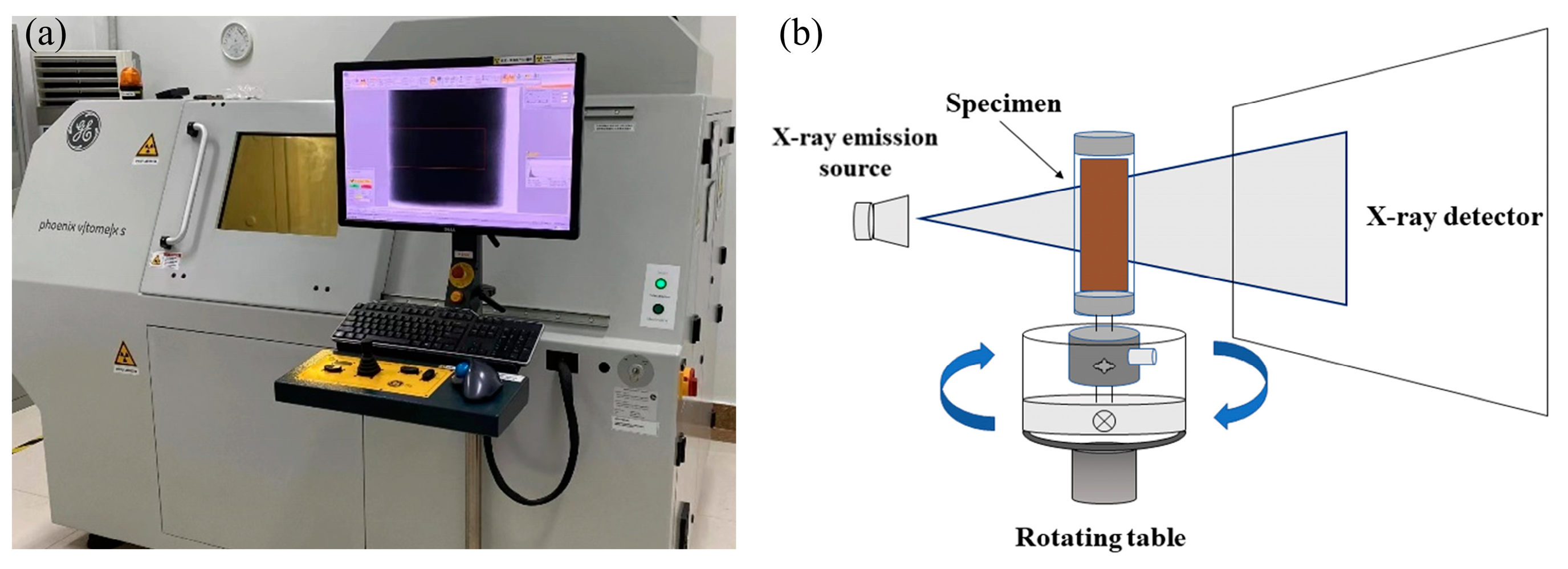

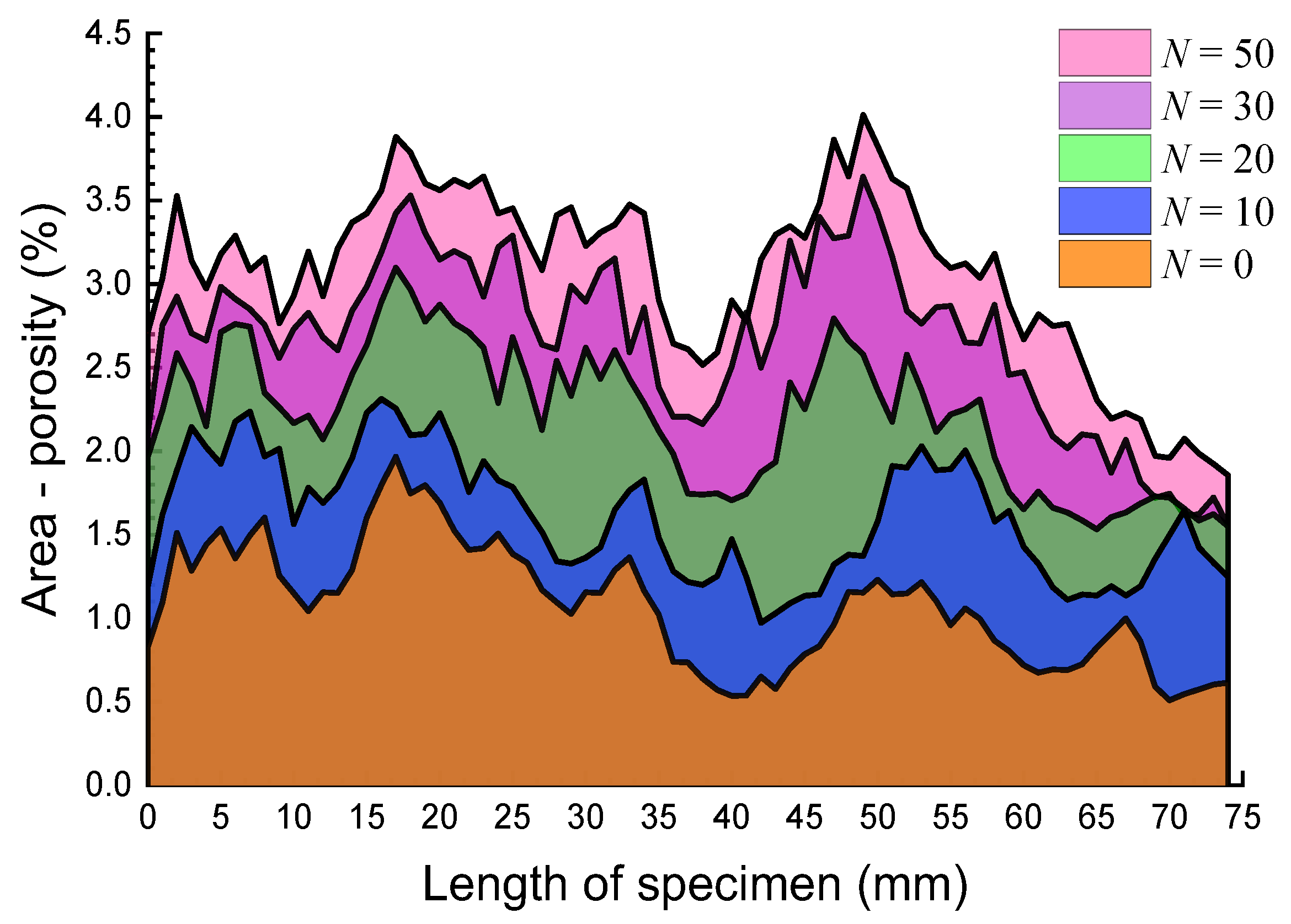
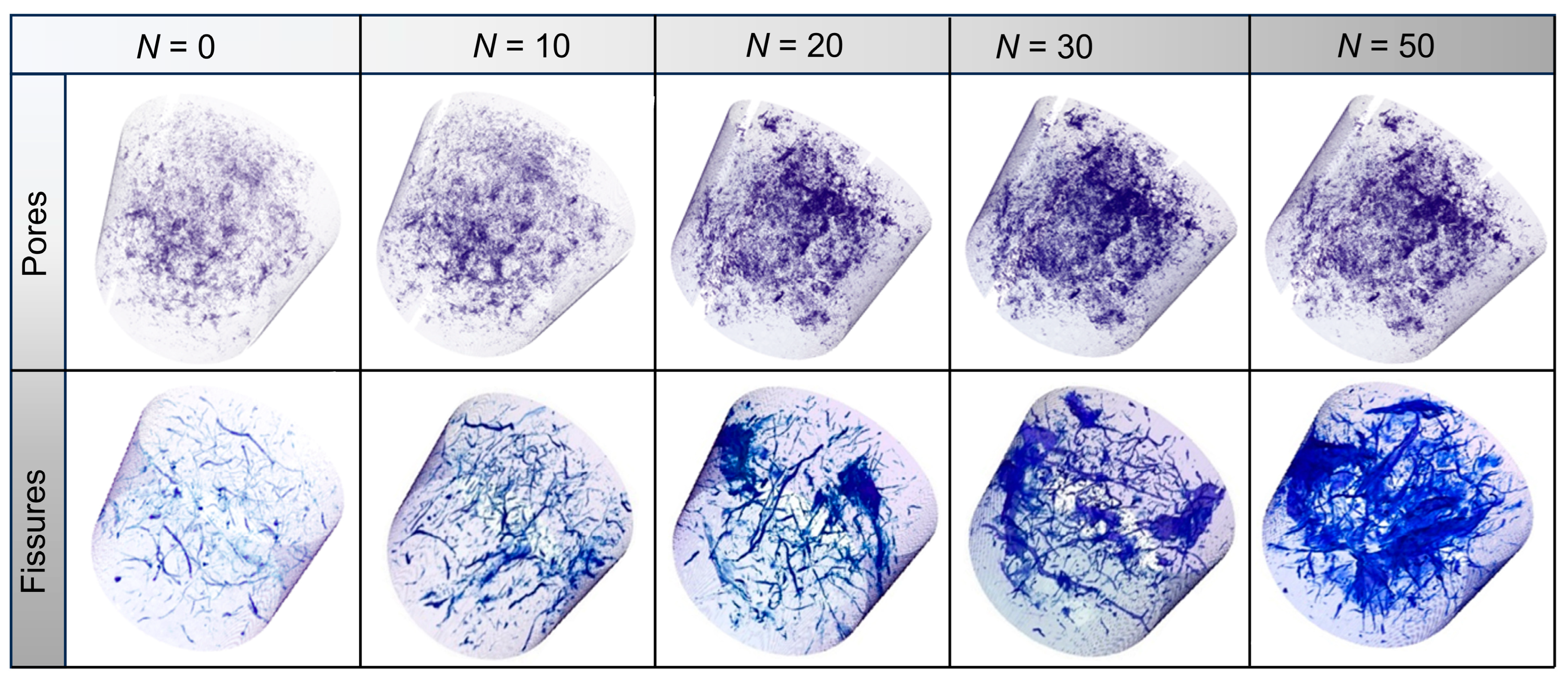
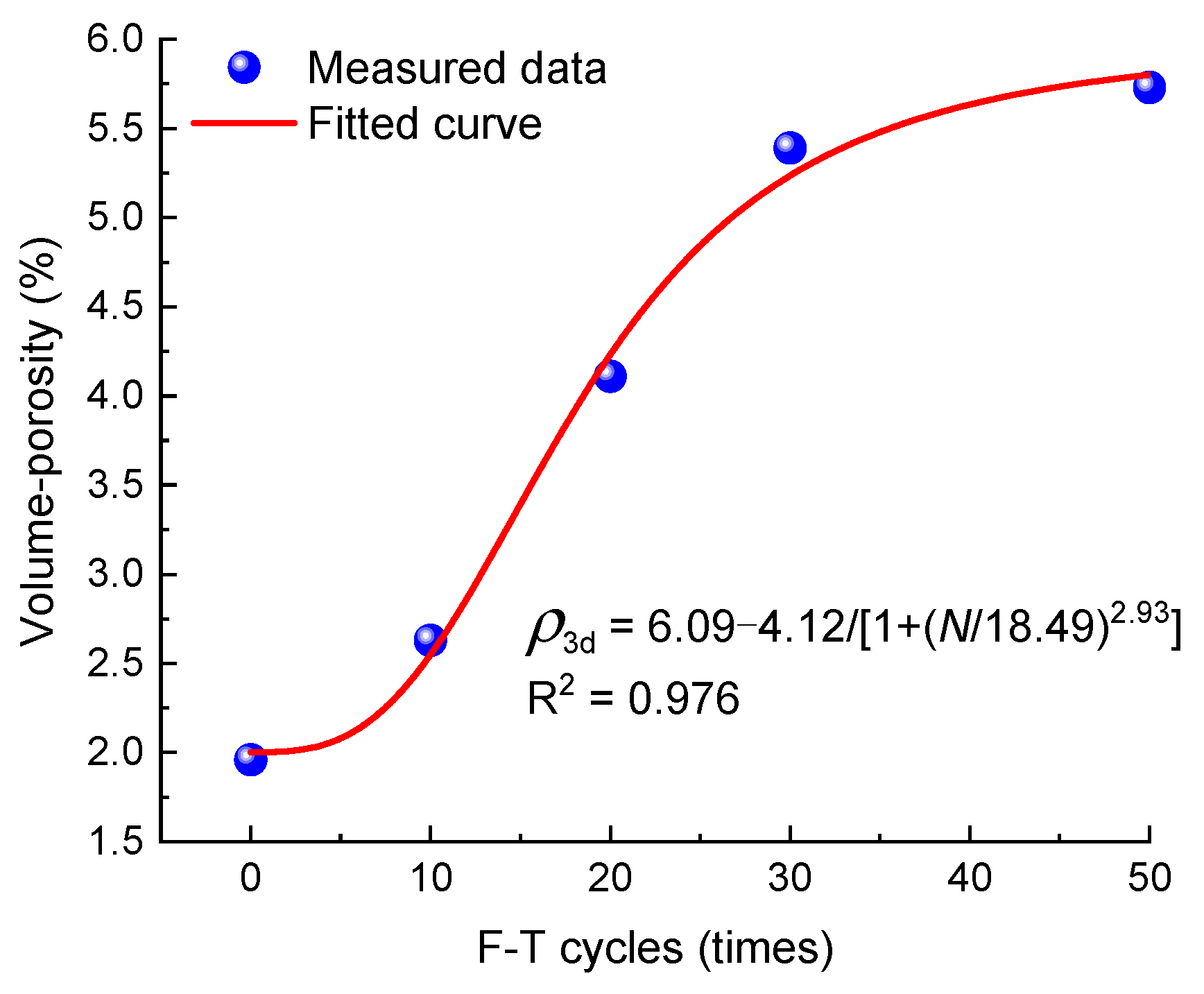
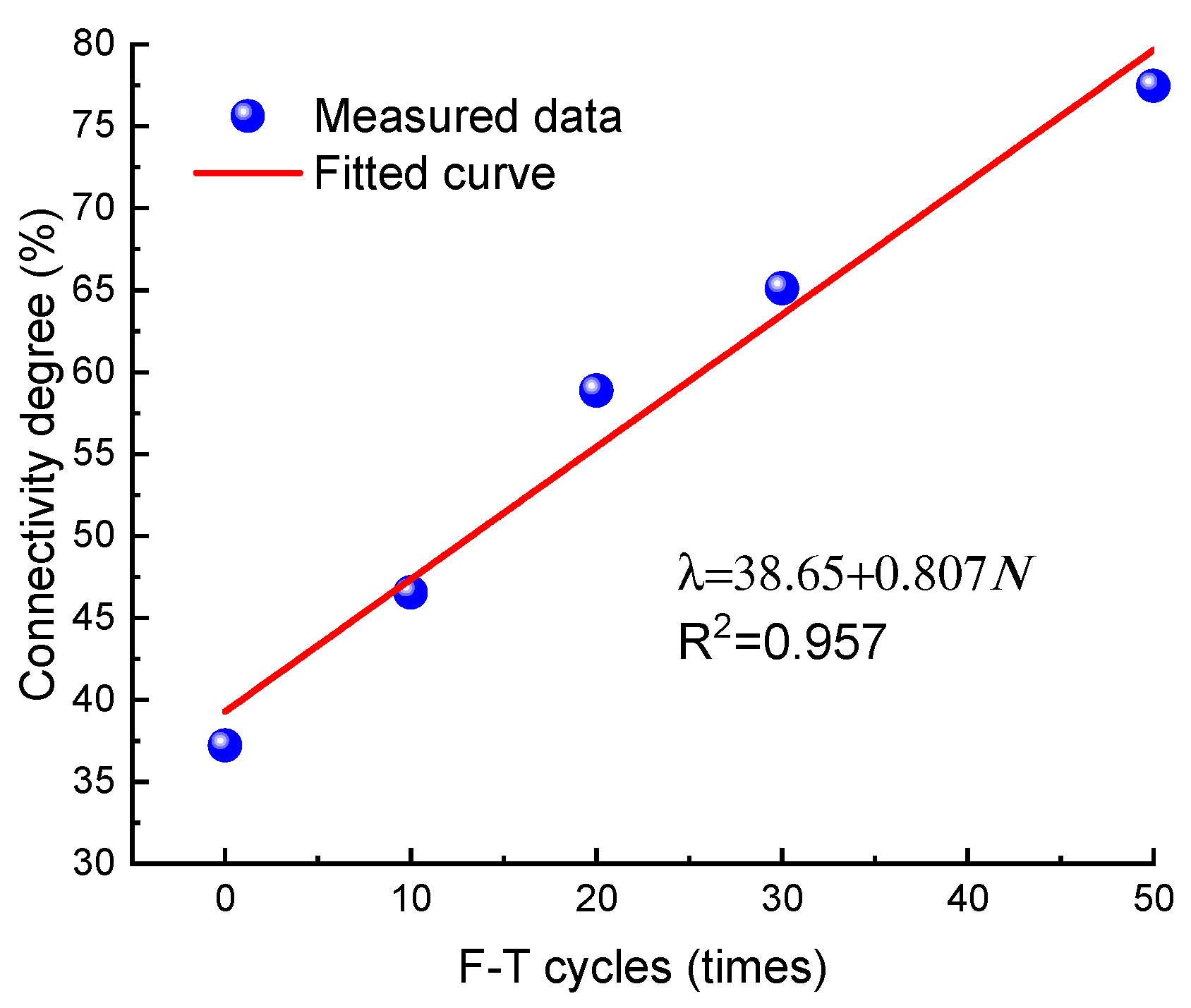

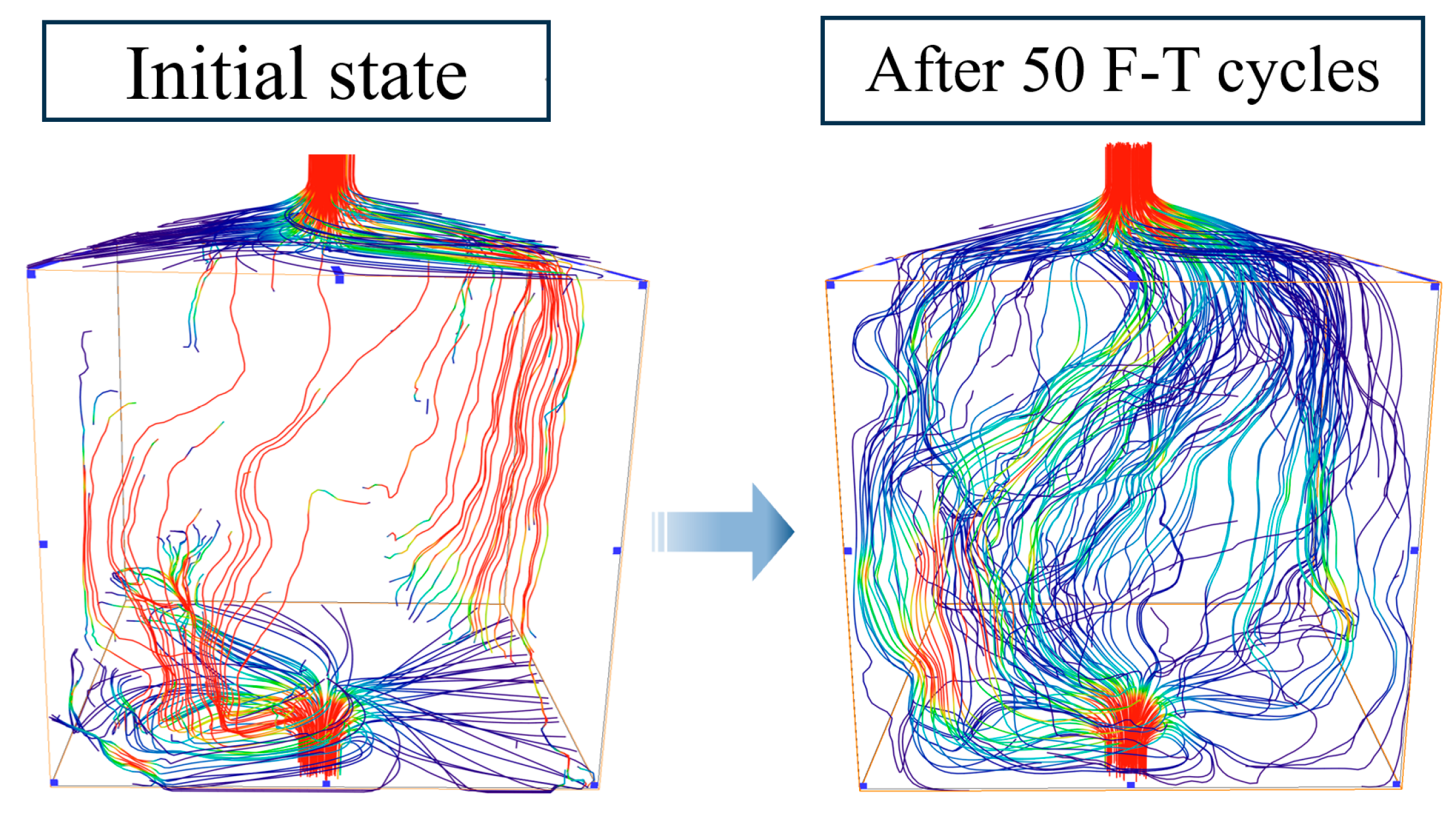
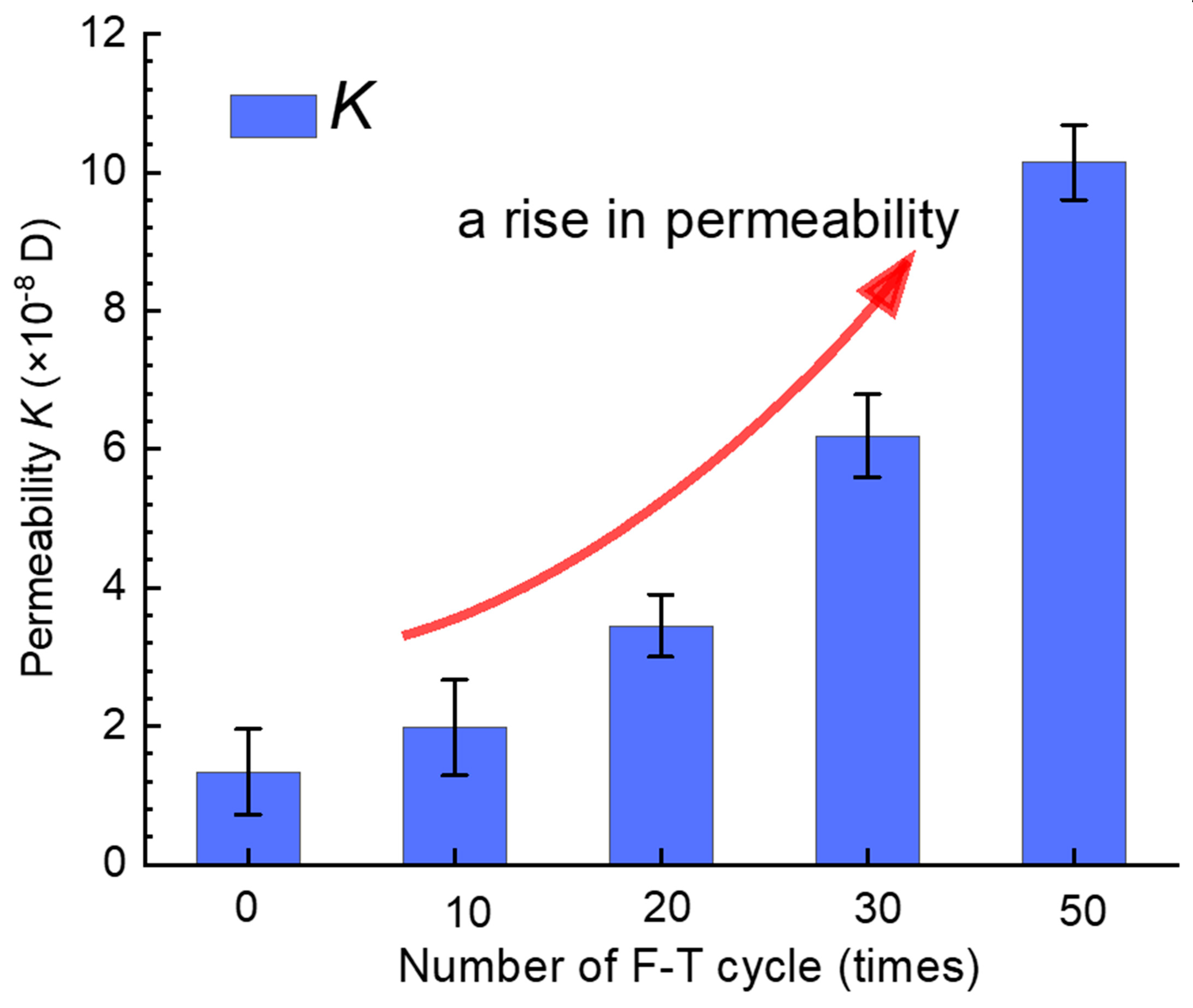
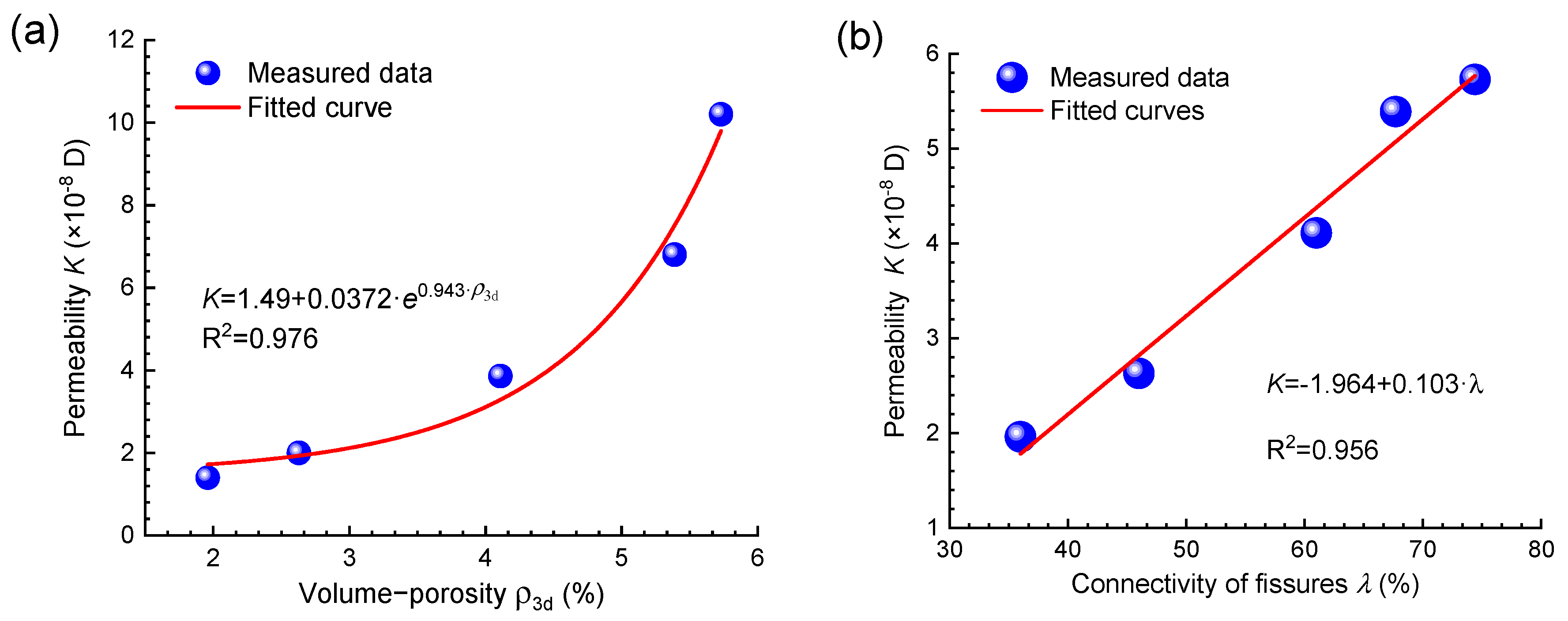
| Physical Property | Value |
|---|---|
| Moisture content (%) | 22.9 |
| Density (g/cm3) | 2.09 |
| Specific gravity | 2.70 |
| Initial porosity (%) | 11.9 |
| P-wave velocity (m/s) | 2336 |
| Permeability (cm/s) | 1.03 × 10−5 |
| Unconfined compressive strength (MPa) | 2.68 |
| Mineral Composition (%) | Value |
| Quartz | 32.8 |
| Feldspar | 13.5 |
| Hydromica | 8.4 |
| Montmorillonite | 12.9 |
| Kaolinite | 24.4 |
| Chlorite | 4.3 |
| Others | 0.7 |
| Number of F–T Cycles | Standard Deviation | Variance | Averaged Value (%) | Median (%) |
|---|---|---|---|---|
| 0 | 0.375 | 0.145 | 1.128 | 1.112 |
| 10 | 0.407 | 0.167 | 1.629 | 1.528 |
| 20 | 0.461 | 0.211 | 2.236 | 2.089 |
| 30 | 0.527 | 0.277 | 2.709 | 2.716 |
| 50 | 0.575 | 0.332 | 5.954 | 3.172 |
Disclaimer/Publisher’s Note: The statements, opinions and data contained in all publications are solely those of the individual author(s) and contributor(s) and not of MDPI and/or the editor(s). MDPI and/or the editor(s) disclaim responsibility for any injury to people or property resulting from any ideas, methods, instructions or products referred to in the content. |
© 2024 by the authors. Licensee MDPI, Basel, Switzerland. This article is an open access article distributed under the terms and conditions of the Creative Commons Attribution (CC BY) license (https://creativecommons.org/licenses/by/4.0/).
Share and Cite
Liu, Z.; Xiang, Y.; Liu, W.; Huang, J.; Liang, Z.; Zhang, Q.; Li, W. Effect of Freeze–Thaw Cycles on Microstructure and Hydraulic Characteristics of Claystone: A Case Study of Slope Stability from Open-Pit Mines in Wet Regions. Water 2024, 16, 640. https://doi.org/10.3390/w16050640
Liu Z, Xiang Y, Liu W, Huang J, Liang Z, Zhang Q, Li W. Effect of Freeze–Thaw Cycles on Microstructure and Hydraulic Characteristics of Claystone: A Case Study of Slope Stability from Open-Pit Mines in Wet Regions. Water. 2024; 16(5):640. https://doi.org/10.3390/w16050640
Chicago/Turabian StyleLiu, Zhifang, Yang Xiang, Wei Liu, Jianyu Huang, Zhu Liang, Qinghua Zhang, and Wenlong Li. 2024. "Effect of Freeze–Thaw Cycles on Microstructure and Hydraulic Characteristics of Claystone: A Case Study of Slope Stability from Open-Pit Mines in Wet Regions" Water 16, no. 5: 640. https://doi.org/10.3390/w16050640
APA StyleLiu, Z., Xiang, Y., Liu, W., Huang, J., Liang, Z., Zhang, Q., & Li, W. (2024). Effect of Freeze–Thaw Cycles on Microstructure and Hydraulic Characteristics of Claystone: A Case Study of Slope Stability from Open-Pit Mines in Wet Regions. Water, 16(5), 640. https://doi.org/10.3390/w16050640





